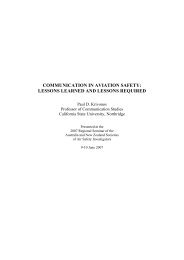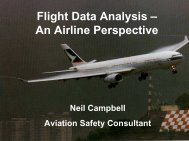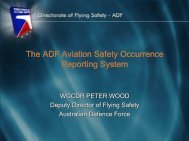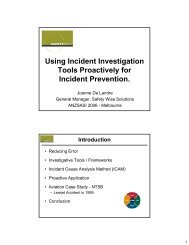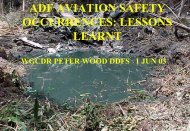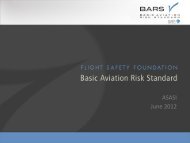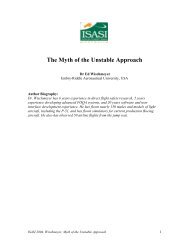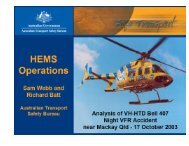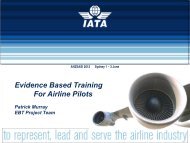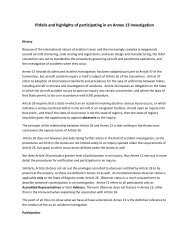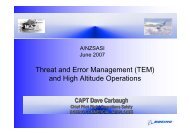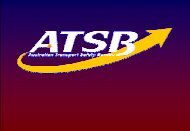Safety Cases: Beyond Safety Management Systems - ASASI
Safety Cases: Beyond Safety Management Systems - ASASI
Safety Cases: Beyond Safety Management Systems - ASASI
You also want an ePaper? Increase the reach of your titles
YUMPU automatically turns print PDFs into web optimized ePapers that Google loves.
<strong>Safety</strong> <strong>Cases</strong>:<br />
<strong>Beyond</strong><br />
<strong>Safety</strong> <strong>Management</strong> <strong>Systems</strong><br />
Dmitri Zotov
Origin of ‘<strong>Safety</strong> Case’<br />
• The Robens Report, 1972:<br />
– Mere compliance with regulations is not<br />
enough to assure safe operation<br />
– The operator must ‘make a case’ that the<br />
operation is acceptably safe
Why a <strong>Safety</strong> Case? Piper Alpha<br />
• On 6 July 1988, a series of explosions<br />
and fires destroyed the Piper Alpha oil<br />
platform and killed 167 people.<br />
• The modern <strong>Safety</strong> Case has been<br />
influenced by the recommendations of<br />
the Cullen Inquiry into the Piper Alpha<br />
disaster.<br />
• Lord Cullen noted in his report that<br />
compliance with detailed prescriptive<br />
regulations was not sufficient to ensure<br />
safety.<br />
• <strong>Safety</strong> Case needed to be owned by the<br />
operators and was to be a “living<br />
document”.
Modern Offshore <strong>Safety</strong><br />
<strong>Management</strong> Practices<br />
• Operator responsible for safety.<br />
• Responsibility to demonstrate<br />
case for safety via a performance<br />
based <strong>Safety</strong> Case – that is,<br />
demonstrate fitness for its<br />
intended context of use.<br />
• Use of formal and structured<br />
hazard identification and analysis<br />
techniques.<br />
• Results of hazard analysis used to<br />
drive design.
Benefits of a <strong>Safety</strong> Case Regime<br />
Source: DNV
History Of <strong>Safety</strong> <strong>Cases</strong> And<br />
Regulation -<br />
Typical UK Reactive Sequence<br />
Accident - Enquiry - Act of Parliament - Guidance
Potential Problems<br />
•Cost<br />
• Ownership<br />
• Competency<br />
• Move to non-prescriptive regulation
<strong>Safety</strong> <strong>Cases</strong> in Civil Aviation<br />
• Part <strong>Safety</strong> <strong>Cases</strong>:<br />
– Eurocontrol: RVSM<br />
– UKCAA: unusual operations<br />
• Delayed introduction of a full <strong>Safety</strong> Case<br />
regime:<br />
– Absence of formal Inquiries in recent years<br />
– Emphasis on SMS
<strong>Safety</strong> Case or Stand-alone SMS?<br />
• A <strong>Safety</strong> Case is analogous to a Business<br />
Plan<br />
• An SMS is analogous to a FMS<br />
• An FMS won’t buy you much without a<br />
Business Plan<br />
• An SMS won’t but you much without a<br />
<strong>Safety</strong> Case<br />
• An SMS is part of a <strong>Safety</strong> Case
<strong>Safety</strong> <strong>Cases</strong> in Civil Aviation<br />
• Eurocontrol<br />
– Partial <strong>Safety</strong> <strong>Cases</strong>, e.g. RVSM<br />
– Draft <strong>Safety</strong> Case manual<br />
• UK CAA<br />
– <strong>Safety</strong> <strong>Cases</strong> required for Aerodromes and Air Traffic<br />
Services<br />
– Under consideration for flight ops and maintenance<br />
• FAA<br />
– Guidance on <strong>Safety</strong> <strong>Cases</strong> for airworthiness standards<br />
(followed by ADF)<br />
• Australia<br />
– CASA :- NAS<br />
– Air Services:- RVSM
Why It Matters to Investigators<br />
• May lead to discovery of corporate factors<br />
behind an accident<br />
• Can point to effective safety<br />
recommendations
The Ansett Case Study<br />
• TOC analysis led to a very few core<br />
problems, but a large number of<br />
recommendations to address them<br />
• All of the recommendations relating to the<br />
airline could be distilled into<br />
– Airlines should be compelled to operate within<br />
a <strong>Safety</strong> Case
What Is A <strong>Safety</strong> Case?<br />
– “A documented body of evidence that provides<br />
a demonstrable and valid argument that a<br />
system or equipment is tolerably safe for use:<br />
within a defined envelope, throughout the<br />
proposed life of the equipment”. (UK MoD JSP<br />
430).<br />
- The body of evidence that the system is safe,<br />
together with the argument that makes sense<br />
of the evidence.<br />
• No reference to Regulatory compliance: the<br />
exact opposite to an Exposition.
Structure Of A <strong>Safety</strong> Case<br />
<strong>Safety</strong><br />
<strong>Management</strong><br />
System<br />
Strategy<br />
Aim<br />
Objectives<br />
Resources<br />
<strong>Safety</strong> Case<br />
Production<br />
System<br />
Description<br />
Assessors<br />
Through Life<br />
<strong>Management</strong><br />
<strong>Safety</strong><br />
Case<br />
SMS<br />
Description<br />
<strong>Safety</strong><br />
Committee<br />
Scope<br />
Targets<br />
<strong>Safety</strong><br />
Case<br />
Report<br />
<strong>Safety</strong><br />
Assessment<br />
Emergency<br />
Procedures<br />
<strong>Safety</strong><br />
Manager<br />
Auditors<br />
Hazard<br />
Identification<br />
Acceptance<br />
Review /<br />
Audit<br />
Hazard Log<br />
Supporting<br />
Argument<br />
Risk<br />
Assessment<br />
Hazard<br />
Control
Exposition, SMS and <strong>Safety</strong> Case<br />
Exposition:<br />
Term used by NZ CAA, and EASA (Maintenance<br />
regulations only)<br />
A document<br />
• Demonstrating compliance with Regulations<br />
• Detailing Company structure, and<br />
• Procedures which will be followed<br />
Underlying Assumption: that compliance with the<br />
Regulations will assure safety
Exposition, SMS and <strong>Safety</strong> Case<br />
<strong>Safety</strong> <strong>Management</strong> System:<br />
• A function of service provision which<br />
ensures that safety risks have been<br />
identified, and the hazards driven down as<br />
far as reasonably practicable<br />
• Assumption behind stand-alone system:<br />
that operating with a SMS, within a<br />
regulatory structure, will assure safe<br />
operation
<strong>Safety</strong> Case, Exposition and SMS
Examining a <strong>Safety</strong> Case<br />
• Documentation:<br />
– Organisation Description/Intent<br />
– Operating History and Incidents<br />
– <strong>Safety</strong> <strong>Cases</strong> and Hazard Assessments<br />
(components)<br />
– Emergency and Contingency Arrangements<br />
• Argument showing that evidence proves<br />
safe operation<br />
• <strong>Safety</strong> <strong>Management</strong> System<br />
• Risk assessment and review
<strong>Safety</strong> Assessment<br />
Observation<br />
Historical accidents<br />
Consequence Analysis<br />
Expert<br />
Judgement<br />
Event Tree<br />
Analysis<br />
Top<br />
event<br />
a<br />
b<br />
c<br />
d<br />
Qualitative<br />
a a a a b b c<br />
a a a b b c c<br />
a b b b c c d<br />
b b c c c d d<br />
b c c c d d d<br />
c c d d d d d<br />
HAZOP, SWIFT<br />
Event Tree<br />
Analysis<br />
Top<br />
event<br />
a<br />
b<br />
c<br />
d<br />
Fault Tree<br />
Analysis<br />
ALARP<br />
Component FMECA<br />
Hazard Identification<br />
Hazard Assessment<br />
Frequency EstimationQuantitative<br />
Hazard Analysis<br />
<strong>Safety</strong> Assessment<br />
Risk Analysis<br />
Risk Assessment<br />
Hazard<br />
Control
As Low As Reasonably Practicable
Setting ALARP Levels<br />
UK Rail has set target levels in two ways:<br />
• Small operator: qualitative<br />
• Large operator: quantitative<br />
Eurocontrol has set quantitative levels:<br />
• Intolerable: 2 x TLS<br />
• Acceptable: .02 x TLS
A <strong>Safety</strong> Case needs to be<br />
Pragmatic
A <strong>Safety</strong> Case needs to be<br />
Pragmatic<br />
Not suitable for children<br />
under 3 years old<br />
If swallowed seek<br />
medical advice
Summary<br />
• <strong>Safety</strong> Case to prove operations are adequately<br />
safe is world’s best practice<br />
• Being progressively mandated in hazardous<br />
industries world-wide<br />
• In accident investigation, comparing the <strong>Safety</strong><br />
Case with reality can give clues to what went<br />
wrong<br />
• <strong>Safety</strong> Recommendations made in terms of<br />
modifying a <strong>Safety</strong> Case may have generic<br />
application



